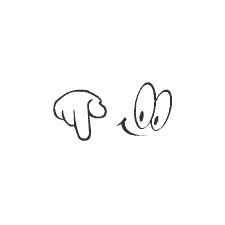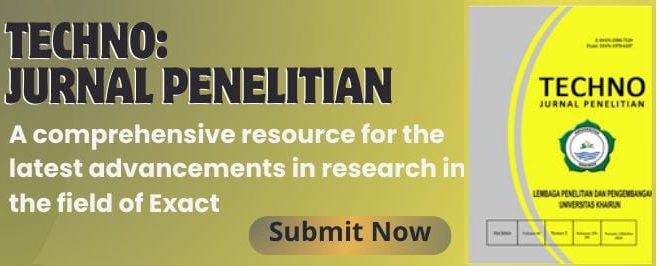Soil Macrofauna Diversity in Organic and Conventional Vegetable Fields in Ternate City
Abstract
This research is a descriptive exploratory study aiming at analyzing the abundance index and diversity index of soil macrofauna in organic and conventional vegetable fields.  The research method used is an entrapment (Pitfall traps) method where traps are installed in a land with 10mx25m of size and results in 10 plots. Each plot has 5 points determined diagonally to place the pitfall traps; therefore, the total sample points are 50 samples per observation location. Identification of macrofauna trapped in the pitfall trap uses a microscope. Based on the results of diversity analysis, soil macrofauna in organic fields has H'2.6546 with an abundance of 2242 individuals, whereas the conventional fields have H'1.6775 with an abundance of 1507 individuals. In terms of dominance index, the conventional fields have a higher evenness of 0225 with a low value of 0229, while the organic fields have a low dominance index of 0077 yet a higher evenness value of 0344. It can be concluded that the diversity of soil macrofauna in the organic vegetable fields in Ternate city has a higher diversity value because the fields have abundant and more even availability of soil macrofauna so that there are no dominant species found. On the other hand, the conventional vegetable fields have low abundance so that the diversity of soil macrofauna in the fields is low due to one dominant species. The results of the analysis in the two fields indicate that the similarity index is 0.803, which means that the similarity value of the macrofauna species in the two fields is close to the index value. An index value is 0 if there are no similar species in both fields and the value is 1 when both fields have the same species composition. However, the diversity of soil macrofauna in the two different fields has an abundance of soil macrofauna so that it can increase soil fertility and maintain the stability of soil macrofauna and its function in a sustainable agricultural system.
Keywords
Full Text:
PDFReferences
Afifah, L., P. Hidayat, D. Buchori, Marwoto, BT Rahardjo. 2015. The Effect of Differences in Plant Agroecosystem Management on the Structure of Insect Communities in Soybean Plantations in Ngale, Ngawi Regency, East Java. J. HPT. Tropics, Vol. 15 (1): 53-63.
Astriyani, NK, 2014. Diversity and Population Dynamics of Fruit Flies (Diptera: Tephritidae) Attacking Fruit Plants in Bali. Thesis Journal. Udayana University, Denpasar. Thing. 49 –73.
Ardiansah S. L, Hasriyanti and Alam A. 2013.Inventory of Arthropods on Soil Surface in Chili Planting (Capsicum annumL.). eJ. Agrotechbis 1 (5): 406-412, December 2013. Tadulako University
Boror, D. J., CA Triplehorn& NF Johnson. 1997. Introduction to Insect Lessons. Yogyakarta: GadjahMada University Press: 1083 pages.
Dedis L, Flora P and Hasriyanti. 2015. Thesis: Insect Diversity in Cocoa Plantation (TheobromacacaoL.) Which is applied with insecticides and without insecticides. Faculty of Agriculture, Tadulako University, Palu
Fachrul, MF 2012.Bioecological Sampling Method. Edition I Mold III. Jakarta: Earth Literacy
Hanafiah, KA 2013. Basics of Land Imu. Jakarta: PT. Raja GrafindoPersada.
Ibrahim, Hasan. 2014. Diversity of Mesofauana Soil in Apple Farming Areas in Tulungrejo Village, Bumiaji District, Batu City as Bioindicators of Soil Fertility and Biology Teaching Materials for Senior High Schools. Thesis of UMM Biology Education. Not published. Poor.
Kurniawati, N. 2015. Diversity and Abundance of Pest Natural Enemies in Rice Habitat manipulated with Flowering Plants. Rice Research Institute. J. Agricultural Science 18 (1): 31-36
NurrohmanEndrik, AbdulkadirRahardjanto, Sri Wahyuni, 2018. Study of the Relationship of Soil Macrofauna Diversity with C-Organic and Soil Organophosphate Content in Chocolate Plantation (TheobromacacaoL.)KalibaruBanyuwangi. Bioexperiment, 4 (1)
Njira, Keston Oliver Willard &Nabwami, Janet. 2013. Soil Management Practices that Improve Soil Health: Elucidating their Implications on Biological Indicators. Journal of Animal & Plant Sciences. 18 (2): 2750-2760
Ma'arifsamsul, Ni made suartini, I Ketutginantra, 2013. Diversity of Soil Surface Insects in Organic Horticulture Farming in Banjar Titigalar, Bangli Village, Baturiti District, Tabanan-Bali Regency. J. BioXVIII (1): 28–32
Pradhana, AI, GatotMudsono, and Sri Karindah. 2014. Diversity of Insects and Spiders in Organic and Conventional Rice Planting. Journal of HPT2 (2): 2338-4336.
Peritaka, MZ 2010. Soil Macrofauna Diversity on Various Sloping Land Agophoresis Patterns in Wonogiri Regency, Central Java . Thesis. Not published
Putra, Muhammad et al. 2012. Soil Macrofauna on UltisolsUnder Different Age Stands of Oil Palm (ElaeisGuineensisJacq.) UNRI Research Journal : Riau
Prihantoro, DE 2013. Composition of the Diversity of Lower Plants after the Eruption of Merapi in Plot 58 RPH Kaliurang, Pakem, Sleman, Yogyakarta. Thesis. GadjahMada University.
Rahmawati, DA 2012.Efforts to Increase Farmers' Income through the Use of Organic Fertilizers (Case Study of Corn Farmers in Surabayan Village, Sukodadi District, Lamongan Regency). Malang: Agribusiness Study Program. Department of Agricultural Social Economics. Faculty of Agriculture. Brawijaya University
Suin, Muhammad Nurdin. 2012 . Soil Animal Ecology . Bandung: Earth Literacy.
Sugiyarto.,UteniWulandari . Wiryanto. 2005. The Effect of Soil Mesofauna and Macrofauna Diversity on the Decomposition of Plant Organic Matter under Sengon (Paraserianthesfalcataria) stands. UNS Research Journal: Surakarta
Siregar, AS, Darmabakti, Fatimah Zahra. 2014. Diversity of Insect Types in Different Types of Rice Fields. Journal of Agroecotechnology 2 (4): 1640-1647.
Soesanthy, F. and IMTrisawa. 2011. Management of Insects Associated with Cashew Plants. Research Bulletin, Vol. 2 (2): 221-230
Supriyadi, S. 2008. Soil fertility of Madura's dry land. Embryo 5; 2; 124-131
Sugiyarto.,Efendi. M., Mahajoeno. E., Sugito. Y., Handayanto. E., Agustina. L. 2007. Preference of Different Types of Soil Macrofauna on Plant Remnants at Different Light Intensities. Biodiversity, 7 (4): 96-10
Usman. A. 2017. Identification of Soil Insects in Patallassang Plantation, Patallassang District, Goa Regency. Thesis. Faculty of Science and Technology. UIN Alauddin Makassar.
Wibowo, C., &Slamet, SA (2017). Soil Macrofauna Diversity in Various Stand Types in the Former Silica Mining Area at Holcim Educational Forest, Sukabumi, West Java. Journal of Tropical Silviculture, 08 (1), 26–34
Zahara, F. 2015. Biological properties of acidic mineral soil dystrudepts in the area of the oil palm disc which was applied Mucunabracteata organic mulch in the experimental field of the Faculty of Agriculture, University of Riau. Thesis. Faculty of Agriculture, University of Riau, Riau. (Unpublished).
DOI: https://doi.org/10.33387/tjp.v10i1.2912
Refbacks
- There are currently no refbacks.
Copyright (c) 2021 Betty Kadir Lahati

This work is licensed under a Creative Commons Attribution-NonCommercial 4.0 International License.
-------------------------------------------------------------------------------------------------------------------------------------------------------------------
-------------------------------------------------------------------------------------------------------------------------------------------------------------------
TECHNO: Jurnal Penelitian
Published by: LPPM Universitas Khairun
Addres : Jalan Yusuf Abdurrahman Kampus II Unkhair, Kelurahan Gambesi, 97722 Kecamatan Kota Ternate Selatan, Provinsi Maluku Utara, Email: techno@unkhair.ac.id | URL: http://ejournal.unkhair.ac.id/index.php/Techno
Techno Jurnal Penelitian is licensed under a Creative Commons Attribution-NonCommercial 4.0 International License.


























